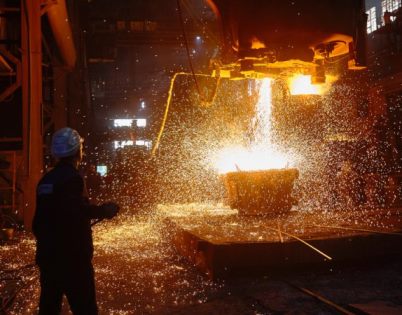How to Invest in IRAN?
Being ranked the second country in the world with highest amount of gas reserves and gas exports, it is not surprising that its Petroleum industry makes Iran’s main source of income and therefore a paradise for businesses to Invest in IRAN . Most of Iran’s oil reserves (about 80%) were discovered before 1965, 70% of which are located onshore. The offshore reserves are located in the Persian Gulf mainly. According to “National Iranian Gas Company“; Iran’s proved gas reserves are 33.8 TCM in 2014.
1. Invest in IRAN Oil and Gas
The oil and gas industry has been the engine of economic growth in Iran, directly affecting public development projects, the government’s annual budget, and most foreign exchange resources. According to OPEC 2016 report; Iran’s Petroleum industry produces about 3.7% (in 2016) of the world’s total crude oil (3.8 million barrels per day).
The last figures that were released by Iran’s Central Bank indicated that this sector constituted about 37.8% of total government revenues.
Having been ranked as the 7th country among the members of Organization of Petroleum Exporting Countries (OPEC) in 2015, Iran exports 1.08 million barrels of crude oil in 2015 and 1.9 million barrels of crude oil in 2016 a day. Some of the features of Iran’s Oil and Gas sector are as follows:
- Owning 9.3% of the world’s proven oil reserves.

IRAN Oil and GAS
- Iran ranks the 4th on a global scale in terms of its 158 bn barrels of oil reserves.
- Iran is endowed with 62 onshore oil fields, 16 offshore oil fields, 20 onshore gas fields, and 2 offshore gas fields that are currently operational in the country.
- Following the uplifting of the sanctions in the year 2015, Iran’s production of oil increased to 3,651 from 3,152 barrels per day and its export of oil witnessed a surge from 1,081 to 1,922.
- Having the shortest route to the large gas market (Caspian region, South East Asia, etc.)
- High production potential (about 1 TCM/Day in the next 4 years, via South Pars and other reserves development).
- Broad infrastructure for taking gas to various consumption areas inside and outside Iran.
- Possibility of export, transit and swap via pipelines to Turkey, Armenia, Iraq, Azerbaijan, Pakistan, Europe, the Persian Gulf region and also via LNG to Asian and European countries
Invest in IRAN Mining
According to the global statistics, Iran is one of the top 10 countries in the world and the first country in the Middle East with rich mineral resources. With 7% of world’s mineral reserves being located in Iran, the country has got variety of opportunities to offer. There are wide variety of mineral resources such as zinc, iron, copper, lead, coal, uranium, chrome, manganese, etc. that are scattered over different parts of the country. Based on the investigations; around 6,000 mines have been identified with more than 68 types of minerals and there are 15,000 of mineral areas with proven reserves of 40 bn tons worth more than 770 bn USD. Some of the features of the Mining sector and its advantages in Iran are as follows:

IRAN Mines
- By having 12 large mines, Iran holds 8% of zinc reserves, 3% of world’s lead, and is the 4th largest producer of decorative stones in the world.
- “SarCheshmeh” Mines in Kerman province contain the world’s 2nd largest lode of copper ore.
- Endowed with 12% of the Persian Gulf region’s aluminum reserves; Iran will boost the production rate to 1.5 million tons by 2025, and turns into one of the top 10 producers of aluminum in the world.
- There are currently 91,000 people employed in the Mining sector in Iran and around 19,000 more who are indirectly involved in this sector. (source: Statistical Center of Iran)
- With an annual output of over 35 million tons, Iran is one of the top 10 global producers of the iron ore.
- More than 70% of about 6,000 mines in the country are currently active.
- Iran’s mining products represent about 4% of the country’s non-oil exports. (2016)
Invest in IRAN Industry
Iran has the largest and the most extended industries among the countries in MENA region and enjoys sufficient infrastructures in upstream, downstream and knowledge-based industries.

IRAN Industry
Iran’s petrochemical industries provide most of the world market necessities by the annual production capacity equal to 60 mn tons. Petrochemical, steel, cement and automotive industry are among the country’s most prominent and successful industries. Some of the features of these four industries are as follows:
Iran’s petrochemical industry has more than half a century of experience and its production capacity reaches over 61.9 mn tons by operating numerous development projects now.
Iran’s total petrochemical production was 50.7 mn tons in the year ended March 2017 and in comparison to the nominal capacity, the average percentage of production was 79.2% during this period.
Presently, Iran is known as the greatest steel producer in the Middle East.
With 17.9 mn tons of crude steel production, Iran is ranked 14th on a global scale in the year 2016.
- Producing 77 mn tons of cement per year, Iran is ranked 13th in the world in this industry.
- Iran exports cement to some two dozen countries including Iraq, Azerbaijan, Turkmenistan, Afghanistan, Russia, Kazakhstan, Kuwait, Pakistan, Qatar, Turkey, the UAE, Georgia, Oman, India, and China.
- Iran’s automotive industry is deemed as the second most important branch of the national economy, after the oil and gas industry with a turnover of 26 bn USD.
- In 2016, Iran became the world’s 18th large automotive manufacturer with an annual production capacity of 2 mn vehicles and over 8,000 people working in this industry.
Infrastructure Invest in IRAN
Iran enjoys a strong and widespread infrastructure in most of its sectors. Iran has a wide range of communication networks including over 214,000 km of road and almost 11,000 km of railways. Other features of modern Iran are, enjoying over 600 operational dams and power plants that generate 76,000 MW of electricity production. Iran transport portion in total GDP is about 9% (2014 ).
According to 2016 statistics; Iran’s railroads transport about 23 million passengers per year via 2,000 operating passenger wagons.
- A booming consumption and production together with new ways of electricity generation, lead Iran to have a promising perspective in electric power industry. Iran’s electricity domestic consumption and production rates have steadily grown together since 1984. Consumption has constantly risen, and it is expected to rise at about 6 percent per year, over the following decade. Iran ranked 14th largest producer, and 17th largest consumer of electricity in 2015 in the world. With numerous projects underway, Iran has offered more incentives to encourage Iranian and foreign investors to invest in electricity generation sector.

IRAN Infrastructure
- Iran is among the top ten manufacturers of gas turbines in the world. Further it has sustained technical expertise to set up hydroelectric, gas, and combined cycle power plants. Not only is Iran self-sufficient in terms of power plant construction, but also has concluded a number of important contracts on implementing projects in the neighboring states.
- Demographic trends and intensified industrialization have caused the electric power demand to grow by 8 percent per year. Iran is also experimenting electricity generation from organic wastes, and plans to build power plants using sewage and organic waste of domestic and industrial origin, as fuel. With nearly 300 clear sunny days a year, and an average rate of 2,200 kilowatt-hour solar radiation per square meter, Iran has a great potential to try out the solar energy as well.
Ferdowsi Trading Center is the first university based trading company in Iran, providing you with the most profitable and safe investment plans in IRAN. We will be glad to hear from you!
 لینک کوتاه این صفحه: ftce.ir/QcYvn
لینک کوتاه این صفحه: ftce.ir/QcYvn








Leave a Reply